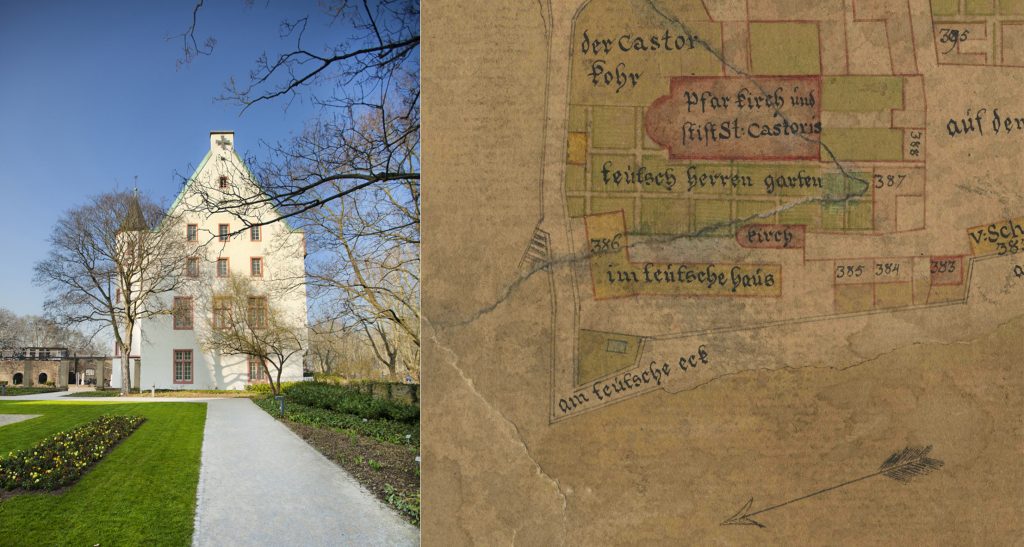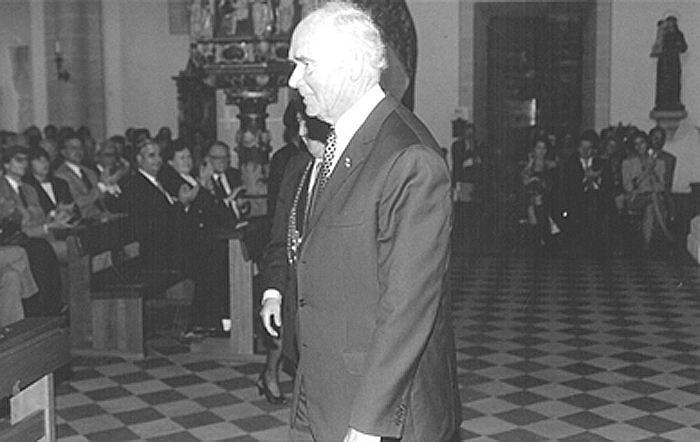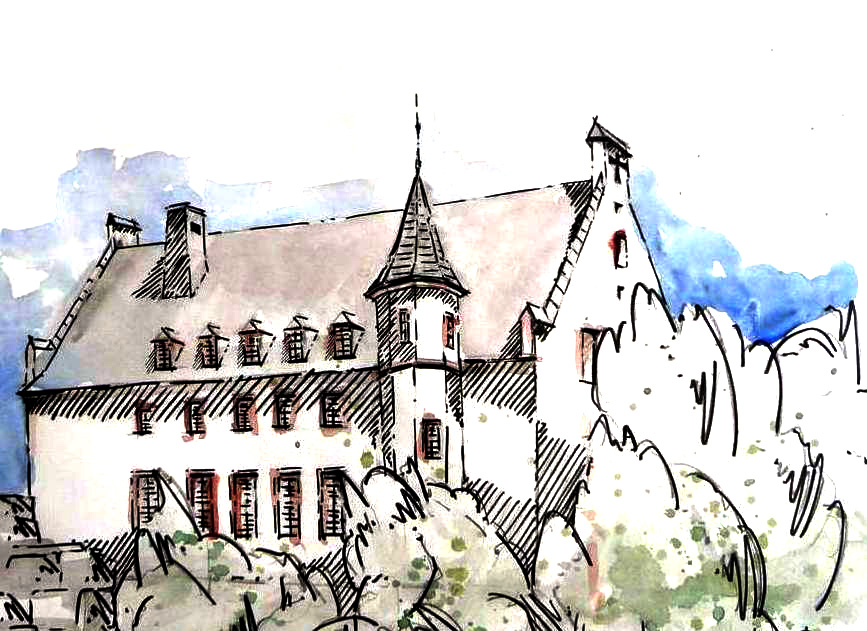Architecture and History
The Teutonic Knights’ House, which gave its name to the “Deutsches Eck” in Koblenz, was the first branch of the Teutonic Order in the Rhineland. In 1216, the Archbishop of Trier, Theoderich II von Wied, called the Knights of the Teutonic Order to Koblenz and gave them part of the grounds of the neighboring Kastorkirche together with the St. Nicholas Hospital located there. This hospital for the poor and pilgrims, founded in 1110 at the Florinsstift, was under the direction of a Spitteler and was cared for by female nurses, mostly beguines. The commandery, established in 1216, was located directly on the banks of the confluence of the Rhine and Moselle rivers. The site was soon referred to as Deutsches Eck. Since the establishment of the Teutonic Order, this site first bore the name “Deutscher Ordt” and then the name “Deutsches Eck”.

In 1794, French revolutionary troops captured Koblenz. Subsequently, the left bank of the Rhine was fundamentally reorganized by the French. With the onset of secularization from 1802 came the end of ecclesiastical rule and thus also the end for the Teutonic Order’s commendation in Koblenz. “[…] The Deutschordens building, which had already served military purposes before, was leased to private individuals after 1800. In 1819, the Prussian military administration set up a provisions magazine there until it was converted into a state archive in 1895” (quoted from: Kerber, Dieter and Udo Liessem: Der Deutsche Orden in Koblenz. Studies on the history and building development in the Middle Ages, Koblenz, Görres-Verl.,1990).
With the construction of the Kaiser Wilhelm Monument in 1897, the name “Deutsches Eck” shifted from the site of the Teutonic Order settlement to the area of the monument. The area now includes not only the historic city wall (with the old cross of the Teutonic Order), but also the new “Deutsches Eck” (German Corner), which was added in the 19th century, with the monumental memorial to Emperor Wilhelm I, as well as the Basilica of St. Kastor, the oldest church in Koblenz, which itself was founded as early as the 9th century. On the opposite side of the Rhine, the visitor comes face to face with Ehrenbreitstein Fortress. From 1990 to 1992, the Deutschherrenhaus was converted into the Ludwig Museum, which was ceremonially opened on September 18, 1992. From the beginning, the focus of the collection and exhibition activities was concentrated on contemporary art of the neighboring country France after 1945.
Zeitgenössische Kunst im historischen Ambiente

The establishment of a museum in the Deutschherrenhaus goes back to the initiative of the famous art collector Peter Ludwig, the art historian and industrialist born in Koblenz in 1925. Peter Ludwig received honorary citizenship of the city of Koblenz in 1986 and, on the occasion of the award, publicly expressed the wish to make parts of his important collection available in Koblenz as well by establishing a museum. It was Peter Ludwig himself who saw in the historic building of the Deutschherrenhaus a place for the Ludwig Museum to be newly founded and who condensed the eventful history of the city of Koblenz with France into a conceptual approach in order to concentrate the loans and donations here entirely on contemporary art after 1945. Originally agreed mostly as permanent loans, Prof. Dr. h.c. mult. Irene Ludwig bequeathed the works formerly declared as loans in their entirety to the Deutschherrenhaus after her death.
Four floors are available for the Ludwig Collection and changing exhibitions. The donation of a collection of excellent works of art in connection with the permanent loan of an extensive bundle of further works formed the basis of today’s internationally cooperating house, whose goal is to offer a lively picture of the French art scene. The collection concentrates on the period after 1945 up to contemporary art and includes works of classical modernism, e.g. by Pablo Picasso, Jean Dubuffet and Serge Poliakoff, and focuses on the “Nouveaux Réalistes” or the “Figuration libre” movement, which is close to the Neo-Expressionists. Important individual works by Pierre Soulages, Martial Raysse, Patrick Raynaud, Daniel Buren and others, as well as a unique collection of the so-called Edition MAT, provide only a sample of the exciting artistic relationships.
Through special exhibitions, numerous monographic exhibitions, as well as thematic references to the museum’s own collection, new content and perspectives are formulated time and again, which do justice to the Ludwig Collection in all its complexity. In addition, there are regular international projects of distinction, which in turn create multi-layered references to the Ludwig Collection and the complex relationships that arise from it.
By focusing its collection on contemporary French art, the Ludwig Museum occupies a decisive position in the German museum landscape, which is also acknowledged in exhibitions, and sees itself as a communicator of significant international artistic positions – certainly also beyond the mainstream. The Ludwig Museum is located in the World Heritage Site of the Middle Rhine Valley and is situated in the middle of one of the most beautiful areas of the city of Koblenz.

800 years Teutonic Knights House,
825 years Teutonic Order
The Teutonic Knights’ House, which gave its name to the “Deutsches Eck” in Koblenz, was the first branch of the Teutonic Order in the Rhineland. More than 800 years ago, Archbishop Theoderich von Wied called the Teutonic Order to Koblenz in 1216, 25 years after it was founded in the Holy Land. The Teutonic Order is still active in Koblenz today. Since 1992, the Ludwig Museum has been located in the Deutschherrenhaus with its collection of primarily French and international contemporary art. The focus of the anniversary year 2016 was the ceremony and summer festival held together with the Teutonic Order under the motto of a medieval and monastic market. Among other things, knight plays and fairy tales, a dragon play, a concert by the Schola of the Choir Foundation Kiedrich, a jubilee exhibition, lectures and a pontifical mass with the Grand Master of the Teutonic Order were offered.
